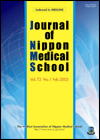Volume 90, Issue 2
Displaying 1-15 of 15 articles from this issue
- |<
- <
- 1
- >
- >|
Photogravure
-
2023Volume 90Issue 2 Pages 138-140
Published: April 25, 2023
Released on J-STAGE: May 30, 2023
Advance online publication: February 21, 2023Download PDF (592K)
Reviews
-
2023Volume 90Issue 2 Pages 141-148
Published: April 25, 2023
Released on J-STAGE: May 30, 2023
Download PDF (1276K) -
2023Volume 90Issue 2 Pages 149-156
Published: April 25, 2023
Released on J-STAGE: May 30, 2023
Advance online publication: February 21, 2023Download PDF (209K) -
2023Volume 90Issue 2 Pages 157-164
Published: April 25, 2023
Released on J-STAGE: May 30, 2023
Download PDF (261K)
Originals
-
2023Volume 90Issue 2 Pages 165-172
Published: April 25, 2023
Released on J-STAGE: May 30, 2023
Advance online publication: February 21, 2023Download PDF (445K) -
2023Volume 90Issue 2 Pages 173-178
Published: April 25, 2023
Released on J-STAGE: May 30, 2023
Advance online publication: February 21, 2023Download PDF (264K) -
2023Volume 90Issue 2 Pages 179-185
Published: April 25, 2023
Released on J-STAGE: May 30, 2023
Advance online publication: February 21, 2023Download PDF (262K) -
2023Volume 90Issue 2 Pages 186-193
Published: April 25, 2023
Released on J-STAGE: May 30, 2023
Advance online publication: February 21, 2023Download PDF (335K) -
2023Volume 90Issue 2 Pages 194-201
Published: April 25, 2023
Released on J-STAGE: May 30, 2023
Download PDF (423K) -
2023Volume 90Issue 2 Pages 202-209
Published: April 25, 2023
Released on J-STAGE: May 30, 2023
Advance online publication: February 21, 2023Download PDF (149K) -
2023Volume 90Issue 2 Pages 210-219
Published: April 25, 2023
Released on J-STAGE: May 30, 2023
Advance online publication: February 21, 2023Download PDF (132K) -
2023Volume 90Issue 2 Pages 220-227
Published: April 25, 2023
Released on J-STAGE: May 30, 2023
Advance online publication: February 21, 2023Download PDF (496K) -
2023Volume 90Issue 2 Pages 228-236
Published: April 25, 2023
Released on J-STAGE: May 30, 2023
Advance online publication: February 21, 2023Download PDF (990K)
Case Reports
-
2023Volume 90Issue 2 Pages 237-239
Published: April 25, 2023
Released on J-STAGE: May 30, 2023
Advance online publication: January 25, 2022Download PDF (191K) -
2023Volume 90Issue 2 Pages 240-244
Published: April 25, 2023
Released on J-STAGE: May 30, 2023
Advance online publication: January 25, 2022Download PDF (632K)
- |<
- <
- 1
- >
- >|
